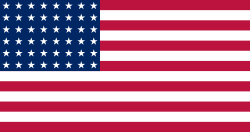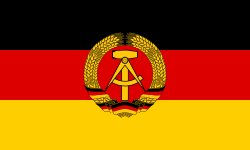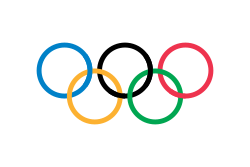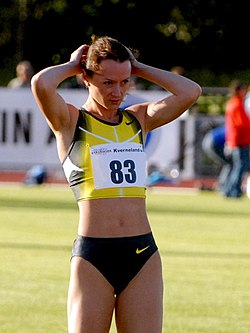Jelena Slesarenko
| Jelena Slesarenko | ||
Jelena Slesarenko. | ||
| Friidrott | ||
| Nation: | ||
|---|---|---|
| Guld | Aten 2004 | Höjdhopp |
| VM inomhus | ||
| Guld | Budapest 2004 | Höjdhopp |
| Guld | Moskva 2006 | Höjdhopp |
| Silver | Valencia 2008 | Höjdhopp |
Jelena Vladimirovna Slesarenko (ryska: Елена Владимировна Слесаренко), född den 28 februari 1982 i Volgograd, Ryska SSR, Sovjetunionen är en rysk friidrottare som tävlar i höjdhopp.
Slesarenkos stora genombrott kom under 2004 då hon började med att bli världsmästare inomhus när hon klarade 2,04 vid VM i Budapest. Utomhus samma år blev hon olympisk mästare vid Olympiska sommarspelen 2004 i Aten när hon klarade 2,06. Efter att ha säkrat det olympiska guldet försökte hon tre gånger på världsrekordhöjden 2,10 utan att klara.
Under säsongen 2005 drabbades Slesarenko av skador och missade VM i Helsingfors.
Under 2006 försvarade hon sitt VM-guld inomhus när hon klarade 2,02 vid tävlingarna i Moskva. Vid Europamästerskapen i Göteborg 2006 blev Slesarenko bara femma efter att ha misslyckats med att klara 2 meter. Hon deltog även vid VM 2007 i Osaka där hon klarade 2,00 vilket trots detta bara räckte till en fjärde plats.
Under 2008 blev hon tvåa vid VM inomhus i Valencia efter Blanka Vlašić. Utomhus deltog hon vid Olympiska sommarspelen 2008 i Peking där hon klarade 2,01. Trots det fick hon se sig slagen av Tia Hellebaut, Vlašić och Anna Tjitjerova i den rekordjämna finalen.
Personliga rekord
- 2,06 utomhus
- 2,04 inomhus
Källor
- Jelena Slesarenko på World Athletics webbplats
| |||||||||||||
| |||||
Media som används på denna webbplats
De olympiska ringarna, med genomskinlig bakgrund.
(c) OOjs UI Team and other contributors, MIT
An icon from the OOjs UI MediaWiki lib.
The Canadian Red Ensign used between 1921 and 1957.
This image has compared for accuracy (mainly colors) using an image from World Statesmen. The only change is making the maple leaves green from red. This image has compared for accuracy (mainly colors) using an image from World Statesmen. The most recent version of this image has changed the harp into one with a female figure; see [http://flagspot.net/flags/ca-1921.html FOTW
The Canadian Red Ensign used between 1921 and 1957.
This image has compared for accuracy (mainly colors) using an image from World Statesmen. The only change is making the maple leaves green from red. This image has compared for accuracy (mainly colors) using an image from World Statesmen. The most recent version of this image has changed the harp into one with a female figure; see [http://flagspot.net/flags/ca-1921.html FOTW
US Flag with 48 stars. In use for 47 years from July 4, 1912, to July 3, 1959.
Flag of Hungary from 6 November 1915 to 29 November 1918 and from August 1919 until mid/late 1946.
Flag of South Africa, used between 1928 and 1982. It is identical to the 1982 to 1994 version except that the shade of blue is darker. It is also known as the "Oranje-Blanje-Blou".
Flag of Romania (28 March 1948 - 24 September 1952)

Construction sheet of the Flag of Romania as depicted in Decree nr. 972 from 5 November 1968.
- l = 2/3 × L
- C = 1/3 × L
- S = 2/5 × l
Olympic Movement flag
Proportions 2:3, created 1913, adopted 1914, first used 1920.
- Colors as per http://fairspielen.de/wp-content/uploads/2015/09/Annexe-3-Olympism_and_the_Olympic_Symbol_-_Principles_and_Usages_Guide-1.pdf
- blue: PMS 3005C
- yellow: PMS 137C
- black: PMS 426C
- green: PMS 355C
- red: PMS 192C
- Dimensions of the rings taken from http://fairspielen.de/wp-content/uploads/2015/09/Annexe-3-Olympism_and_the_Olympic_Symbol_-_Principles_and_Usages_Guide-1.pdf
The civil ensign and flag of Belgium. It is identical to Image:Flag of Belgium.svg except that it has a 2:3 ratio, instead of 13:15.
















